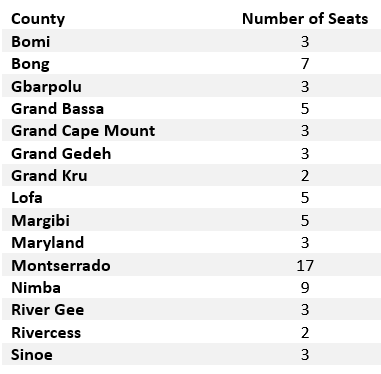Election without boundary delimitation? The 2023 legislative elections and their implications for fair and balanced representation in Liberia
Map of Liberia showing the counties with their population figures, 2022. Source: Daily Observer Newspaper
Introduction
Democracy is sometimes misconstrued to be the regular conduct of elections and for the process to be declared, free, fair, and transparent. However, democracy also entails adequate representation. According to the Liberian constitution, a county and electoral district ought to be adequately represented in both the Senate and House of Representatives. The standard established for adequate representation is outlined in Constitution of Liberia of 1986 which defines representation in terms of population size matched against the area. In post-war Liberia, the uneven distribution of the population across the country continue to persist. Much of this uneven distribution has been triggered by migration and the legacy of the war.
The conflict involuntarily displaced one-third of the population. Some Liberians were uprooted from their place of abode and relocated to other parts internally, while others fled the country and sought safety elsewhere. Though the war ended more than 20 years ago, some regions and counties are yet to be fully restored to pre-war standards. Also, Liberia’s post-war development has been shaped by certain ‘growth corridors’ that seem to be reinforcing conditions of inequality.
As government and development donors invest more resources in developing these growth corridors, they have become the push and pull factors for migration. Accordingly, it has set in motion, a certain pattern of rural to urban migration. Due to these migration patterns, some counties are being depopulated while others are overly-populated. Some counties are in fact far more populated than they were before the war, while others sparsely populated. These patterns of rural to urban migration has led to issues of underrepresentation in some parts and over-representation in others. In this policy brief, Ducor Institute examines the constitutionality of underrepresentation and over-representation.
Representation in the Legislature
Liberia’s system of representative democracy provides for the direct election of legislators to the two separate houses: House of Senate and House of Representatives. The Liberian Senate, commonly called the ‘Senate’ or ‘Upper House’ is comprised of 30 senators who represent the fifteen counties — the main political subdivisions. Each county, regardless of area size or population, is represented by two senators elected by registered voters across the county.
On the other hand, the House of Representatives (or the Lower House) is comprised of representatives elected by registered voters to represent citizens in the electoral districts (constituencies). The electoral districts are single-member districts determined by population figures. Following the 2008 census, new electoral districts were drawn following a redistricting exercise, thereby increasing the members of the House to 73 representatives from 64. That exercise, however, was not systematically determined by the results of the census.
The 2023 Elections and the electoral boundaries
Liberia’s general and presidential – elections were held nearly one year after the second postwar census of 2022. A record 78.86 percent of registered voters turned out to vote in a process that was largely peaceful. Incumbent President George Weah of the Coalition for Democratic Change is expected to face his main opposition Joseph Boakai of the Unity Party in a runoff election, in November, since no candidate won an absolute majority (of 50% plus one, or above) of the total vote cast. A record number of incumbent legislators will not be returning to the legislature. For instance, only four of the thirteen Senators who sought reelection are likely to return. Some of the results have been challenged at the National Elections Commission (NEC).
Concealed in this process, however, is the fact that the incoming legislature will not be fully representative of the current population distribution in the country — as the provisional results of the 2022 census and the voter registration figures show. The current electoral districts, from which members of the House of Representatives are elected, have the most significant population inequalities and power imbalances in recent political history. Thousands of people will remain underrepresented or completely underrepresented because of the failure of the various stakeholders to carry out the boundary delimitation and redistricting processes ahead of the 2023 elections.
Boundary delimitation, the process by which electoral districts are established for representation, is crucial in every democracy and it is a routine exercise, usually determined by changes in population or socio-economic and political dynamics. Although the Constitution mandates the delimitation of electoral constituencies after every census, and despite a (nearly) 50% increase in population since 2008, the elections proceeded without a redistricting exercise. The consequences, as discussed below, are several overpopulated electoral districts in some parts of the country, and disproportionately smaller ones in other parts. Thus, the failure to use recent data collected by the 2022 Housing and Population Census to conduct careful boundary delimitation of overpopulated electoral districts is unconstitutional.
The constitution and boundary delimitation
In other countries, many factors, such as geography, demographic and socio-economic conditions, are used around the world to establish electoral constituencies. In Liberia, the primary (and only) factor considered is population size. The Constitution mandates the National Elections Commission (NEC) to reapportion electoral constituencies following each national census — using the results of the census. When the Constitution was adopted in1986, Liberia’s population was estimated at 2.1 million (1984 Census). It was based on this population figure that the Constitution reasonably provides that electoral constituencies ‘shall have an approximately equal population of 20,000’ citizens.
In anticipation of steady population growth, the Constitution also grants the Legislature powers to prescribe the population size of electoral constituencies when so required – following each census. However, the Legislature has yet to effectively use this power to provide for fair, balanced, and equal representation of the population in the House despite two successive censuses since the end of the civil war in 2003.
Even though the current 73 electoral districts were established after the 2008 census —which estimated the population at 3.5 million— the electoral districts were determined using the 2011 voter registration data, not the census data.
This followed intense debates and political compromises between the Legislature and the Executive. Following the 2008 census, the legislature proposed a constituency threshold bill that would have increased the number of representatives significantly, but President Ellen Johnson-Sirleaf (2005 – 2017) objected to the proposal, citing the prohibitive cost implications on public finances. On the other hand, legislators from counties with smaller populations refused to accept any reduction in their numbers. This impasse was only broken when both sides agreed that all counties would retain their existing seats and that nine additional seats would be distributed to counties with higher populations. Consequently, three House seats were assigned to Montserrado, two to Nimba, one to Lofa, Bong, Grand Bassa, and Margibi each. As for the two counties with the smallest population figures, Grand Kru and Rivercess, the consensus was to allow them to retain their two seats each.
The table below shows the current distribution of seats in the House as established in 2011.
Distribution of seats in the House of Representatives
Representation after the 2023 elections
The legislature that will emerge out of the 2023 elections will have a disproportionately higher number of representatives for sparsely populated counties. Conversely, densely populated counties, particularly those experiencing rapid urbanization such as Montserrado, Nimba, and Margibi will have comparatively lower representatives. The following are clear observations from both the provisional results of the census and the voter registration figures from the counties.
Densely populated counties will be under-represented
Montserrado County, with over one-third of the population (36.59%) — and over one-third of registered voters (36.46%) — will have 23% of the seats in the House of Representatives.
Montserrado and Nimba Counties, with about half of the entire population (48.44%) will together occupy just a little over one-third of the seats (35.61%) in the House of Representatives.
Sparsely populated counties will be grossly over-represented
Although Gbarpolu County has only 1.82% of the population — and 2% of registered voters — it will occupy over 4% of the seats in the House of Representatives.
River Gee County with only 2.37% of the population will have 4.10% (three seats) in the House. In terms of voting population, River Gee County has 1.52% of total national voter as compared to Electoral District One (ED1) of Lofa County which has 1.61% of total voters. However, the former has two more House seats than the latter.
Although Rivercess County has 5.64% more voters than River Gee County, the former will have 1 seat less than the latter.
Uneven electoral districts per voters
Voter population per electoral district are unevenly distributed nationwide to the extent that the number of registered voters in some districts more than double the number in other districts. This uneven distribution is in flagrant violation of the Constitution which provides in Article 80(d) that ‘each constituency shall have an approximately equal population…’. Districts are strikingly uneven across the country and within some counties – per voter registration figures.
Montserrado Electoral District Four (ED4), the most populous electoral district with 81,527 registered voters, is six times (per voter registration figure) the size of River Gee Electoral District One (ED1) which has only 12,008. This implies that the representative of Montserrado ED4 will be representing 69, 515 more people than the representative of River Gee ED 1.
Margibi ED1 alone has more registered voters, 65,563, than the total number of registered voters in the three electoral districts in Bomi County (Bomi ED1, ED2, and ED3) with a total voting population of 63,112. This suggests that Districts in Bomi will be overrepresented while Margibi ED1 will be underrepresented.
Also, Margibi ED1 which has 65,563 voters is more than twice that of Margibi ED5 which has 29,961 voters.
The regional inequity in representation is stark
The five counties of the Southeast will be overrepresented in the House of Representatives. The provisional results of the 2022 Census also show stark regional inequity, as seen below.
Four counties in western Liberia (Bomi, Gbarpolu, Grand Cape Mount, and Montserrado) with nearly half of the population (44.3%) will be represented by 35.6% in the House of Representatives; while six counties in the southeastern region (Grand Gedeh, Grand Kru, Maryland, Rivercess, River Gee, and Sinoe) with only 16% of the population, will together occupy 22% of the seats in the House. Therefore, the four western region counties will have fewer representatives compared to their population size while the southeastern counties will have more representatives even though the region is sparsely populated.
Four counties in the northcentral region (Bong, Lofa, Margibi and Nimba) with 33.5% of the population
Conclusion
The current electoral districts in Liberia do not reflect the current growth in the size of the population, neither are they established in line with the Constitution of Liberia. As Liberia consolidates its democracy and its population grows, especially in urban areas, it is constitutionally imperative to continually review the country's single-member electoral constituencies to ensure equitable representation in the House of Representatives. The 55th Legislature is therefore encouraged to consider boundary delimiting as a crucial priority for electoral reform. Finally, given the technical nature of this exercise, the legislature and the NEC are further encouraged to establish and work with an independent committee of experts on redistricting and boundary delimitation whose responsibilities shall include providing sound, technical advice on redistricting and communicating with the public on the merits of this exercise.


